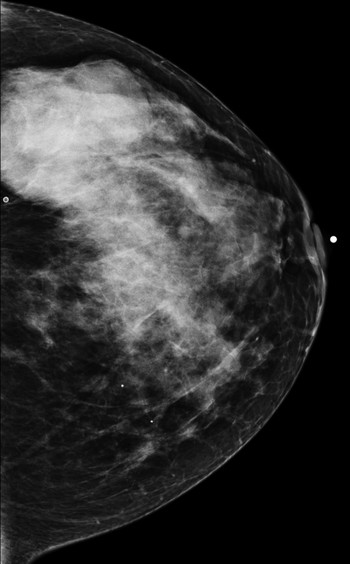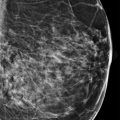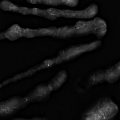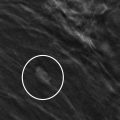Presentation and Presenting Images
( ▶ Fig. 58.1, ▶ Fig. 58.2, ▶ Fig. 58.3, ▶ Fig. 58.4, ▶ Fig. 58.5)
A 49-year-old female with elevated lifetime risk for breast cancer (20%) presents for routine screening mammography.
58.2 Key Images
( ▶ Fig. 58.6, ▶ Fig. 58.7, ▶ Fig. 58.8, ▶ Fig. 58.9, ▶ Fig. 58.10)
58.2.1 Breast Tissue Density
The breasts are heterogeneously dense, which may obscure small masses.
58.2.2 Imaging Findings
The imaging of the right breast is normal (not shown). The left breast demonstrates a 3-cm mass (circle) in the upper outer quadrant of the left breast in the posterior depth, 5.5 cm from the nipple ( ▶ Fig. 58.6 and ▶ Fig. 58.7). The mass has increased in size since the prior mammogram ( ▶ Fig. 58.8 and ▶ Fig. 58.9). The mass is best seen on the left craniocaudal (CC) tomosynthesis slice 36 of 85 ( ▶ Fig. 58.10). It is not well seen on the left conventional mediolateral oblique (MLO) mammogram ( ▶ Fig. 58.7) or the MLO tomosynthesis movie.
58.3 BI-RADS Classification and Action
Category 0: Mammography: Incomplete. Need additional imaging evaluation and/or prior mammograms for comparison.
58.4 Diagnostic Images
( ▶ Fig. 58.11)
58.4.1 Imaging Findings
Ultrasound was performed and demonstrated a circumscribed anechoic mass with posterior acoustic enhancement located at 3 o’clock ( ▶ Fig. 58.11). The distance to the mass is 5.5 cm (dotted line). The ultrasound evaluation is consistent with a cyst.
58.5 BI-RADS Classification and Action
Category 2: Benign
58.6 Differential Diagnosis
Cyst: Cystic and solid masses may have similar appearances on mammography. Sonography reliably differentiates cystic and solid masses. This circumscribed anechoic mass with posterior acoustic enhancement is consistent with a simple cyst.
Fibroadenoma: Fibroadenomas are oval masses with parallel orientation. Gentle lobulations (typically fewer than 4) may be present but the margins should be circumscribed. The internal echogenicity may range from isoechoic to hypoechoic.
Cancer: High-grade carcinomas and medullary carcinomas can be markedly hypoechoic and rounded in shape, mimicking complicated cysts.
58.7 Essential Facts
A mass that enlarges over time may be benign or malignant. Benign versus malignant findings may be difficult to distinguish on conventional mammography. Tomosynthesis is helpful to further characterize masses. Sonography is used to determine the cystic or solid nature of a mass.
Cysts result from distension of the terminal duct lobular units (TDLU) due to progressive filling with fluid.
Cysts may be classified as simple, complicated, and complex.
Simple cysts are anechoic, well-circumscribed masses with posterior acoustic enhancement and subtle acoustic edge shadows.
Complicated cysts are not purely anechoic. These cysts contain diffuse low level echoes. Needle biopsy should be performed if this diagnosis cannot be confidently made.
Complex cysts may indicate the presence of malignancy or infection. Complex cysts have solid and cystic components.
58.8 Management and Digital Breast Tomosynthesis Principles
With mammography, a two-dimensional picture (mammogram) is taken of the three-dimensional breast. The third dimension, breast thickness, is projected in a single plane. Overlapping breast tissue limits interpretation in mammography, particularly in women with denser breast parenchyma.
The breast is positioned the same way in tomosynthesis as it is in conventional mammography. The X-ray tube moves in an arc around the breast while images are taken. This data is processed in a sequential slice format from side to side or top to bottom and viewed as a movie, thus allowing for the breast tissue to be viewed as a three-dimensional (3D) object,
These 3D images of tomosynthesis eliminate the overlapping breast tissue and often make lesions more conspicuous.
58.9 Further Reading
[1] Masciadri N, Ferranti C. Benign breast lesions: Ultrasound. J Ultrasound. 2011; 14(2): 55‐65 PubMed
[2] Rahbar G, Sie AC, Hansen GC, et al. Benign versus malignant solid breast masses: US differentiation. Radiology. 1999; 213(3): 889‐894 PubMed

Fig. 58.1 Left craniocaudal (LCC) mammogram.
Stay updated, free articles. Join our Telegram channel

Full access? Get Clinical Tree








